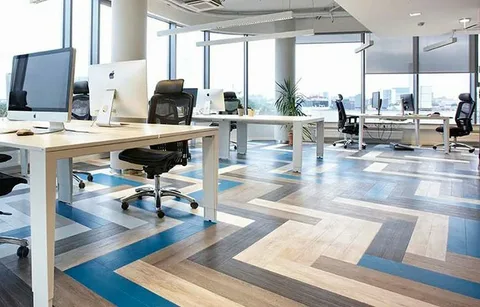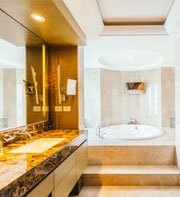How to Select Flooring for Industrial Facilities: Durability Meets Design

When you begin choosing flooring for an industrial facility, the first step is a deep look at what the space will demand. An industrial setting often involves much more than foot traffic: heavy vehicles, forklifts, pallet jacks, machinery vibration, chemical spills, temperature swings, humidity, dust and frequent cleaning. A facility where forklifts and heavy loads roll across the floor requires a very different surface than a light‐duty office annex within the facility. If you map out things like traffic type, loads, chemical exposure, temperature extremes and the presence of visitors or show areas, your flooring choice will be far more effective and lasting.
Translating Conditions into Performance Needs
Once you understand the environment, the next step is thinking about what performance the floor must deliver—especially when considering commercial flooring . The floor should wear well over time, resisting abrasion, dropped loads, heavy equipment, and constant movement. It must also stand up to chemical spills, oils, solvents or cleaning agents if those are present. Safety is another key: oily or dusty floors invite slip risks, so adequate texture, finish and material choice matter. Maintenance and longevity also count—choosing a flooring solution solely on initial cost may lead to frequent repairs or replacement down the road. At the same time, there might be aesthetic demands—areas of the facility where appearance matters, branding plays a part, or visitors must be accommodated. Balancing these demands—durability, safety, maintenance and aesthetics—is the essence of a good choice for commercial flooring Dubai.
Exploring Common Flooring Options
In industrial settings there are several flooring systems worth considering, each offering trade-offs.One of the most fundamental choices is to work with the structural concrete slab of the building and treat it appropriately—such as polishing or sealing it. This gives strong support for heavy loads and tends to keep maintenance simpler. It may lack the design flexibility of other systems, but in raw production zones it often makes sense.
Design, Brand Image and Practical Finish
Even in an industrial facility, design plays a role. The floor isn’t just somewhere things roll over—it forms part of the environment, supports brand image, helps in way-finding, and can contribute to safety via demarcation. In visitor-visible zones, you may want a polished or coloured floor that aligns with your company’s image or creates a clean, modern impression. You might integrate logos, zone colours, or safe walking paths directly into the floor finish. In production zones design is often secondary, but you still should avoid finishes that look obviously worn out or neglected—a well-maintained floor sends a message of quality and care, especially when selecting Parquet flooring Dubai.
A Step-by-Step Approach to Selection
Start by documenting your facility’s demands: the types and weights of traffic, vehicles or pallets; equipment motion; chemicals used; cleaning and maintenance regime; temperature and humidity extremes; and any areas that will be seen by visitors. Then clarify your priorities: in each zone, which is more critical—heavy load capacity, chemical resistance, slip safety, design finish? With those priorities in hand, identify appropriate flooring system options for each zone rather than attempting a single solution for all. Compare not just initial cost but lifecycle cost: how often will the floor need repair or replacement, what downtime might be incurred, what maintenance burden will be placed on staff? Factor in installation logistics: how long the floor will be out of service, what substrate preparation is required, any curing time. Also plan for maintenance: simple cleaning, periodic deep clean, repair of surface damage—choose finishes that will fit with your operational rhythm.
Conclusion
Flooring in an industrial facility is far from a decorative after-thought—it’s a strategic part of the building’s performance, safety, maintenance cost and image. A well-chosen floor supports efficiency, reduces downtime, improves safety, helps maintenance and contributes to a positive impression. When you take the time to understand the environment, translate that into performance needs, explore the right materials for each zone, and balance durability with design where required—you’ll end up with a floor that looks good, works hard, and lasts.
If you like, I can prepare a comparison between four or five specific flooring systems—showing typical costs, pros/cons and suitable zones within an industrial facility—so you can see real option-vs-option. Would you like that?
![]()

As a lifelong DIY enthusiast, Alex Barton is never afraid to go the extra mile to save a few bucks! From seamless interior decor hacks to effective DIY home renovation tips, he shares a myriad of his experiences for you to unleash your creativity.



















